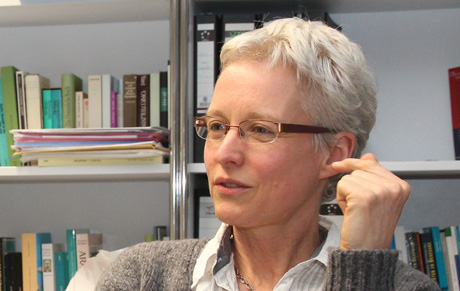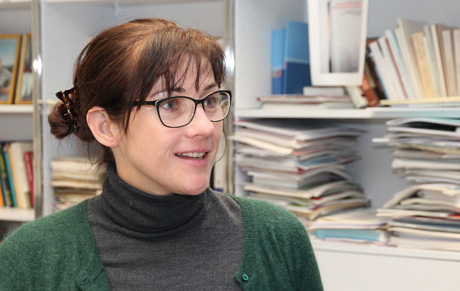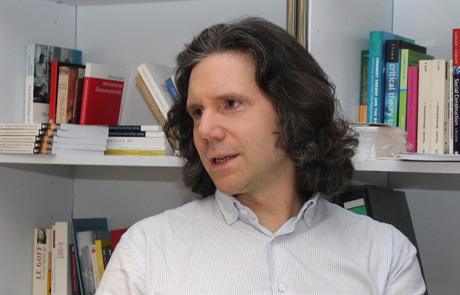Navigation auf uzh.ch
Navigation auf uzh.ch
Among the three Reseach Fields at the URPP Asia and Europe, Research Field 3 is focusing on “Norms and Social Order(s).” In the interview, three of its members – professors David Chiavacci (social science of Japan), Bettina Dennerlein (gender and Islamic studies), and Dorothea Lüddeckens (study of religions) – explain their current collaborative research interest in the ‘circulation’ of norms in connection with forms of ‘political protest.’
Interview: Roman Benz
Professors Chiavacci, Dennerlein, and Lüddeckens, could you explain the interest of Research Field 3 in ‘circulating norms?’
Bettina Dennerlein: Choosing this subject was a result of ongoing discussions on joint research interests inside the URPP. When Research Field 3 was reorganized in 2009, it took up the ambitious task to explore the broad field of “Norms and Social Order(s).” While working on this subject, we were especially concerned with relations of exchange and entanglements between Asia and Europe – many of us being interested in questions related in one way or another to human rights norms. In order to frame our research in a more systematic manner, we find the notion of ‘circulating norms’ very helpful. Initially we used it to describe the complex and often conflicting processes of globalization and transnationalization of human rights norms. But it became obvious that this notion was useful in other contexts as well.

Dorothea Lüddeckens: To clarify our understanding of circulation, we need to emphasize that norms usually undergo more or less distinctive changes if taken over by other societies. A norm developed in Asia may lose all clear signs of its origin in the course of adaptation in Europe. In later times, norms that once travelled to Europe from elsewhere may be adapted in Asia as typical European ones.

Could you give an example?
David Chiavacci: Let me pick Japanese management practices (quality circles, kaizen, etc.) admired in the West. By taking into account the suggestions of the employees on how to improve workflow and production process, these practices essentially increased the productivity of Japanese companies. But this collecting of labor-saving proposals had been developed in the US some decades earlier in connection with the so-called Taylorism and had been implemented in Japan after World War II. Still, Western observers regarded these practices as originally Japanese and even questioned whether they were compatible with Western culture.

How do you define ‘circulating norms’ more precisely?
Dennerlein: We decided to use the concept in a rather open, pragmatic way, allowing for theoretization but not following one strict line. For example, during a workshop on ”Protests, the Media, and the Circulation of Norms,” we discussed together with Scott Rodgers, one of the paper presenters, the approach to globalization developed by Benjamin Lee and Edward LiPuma, who are trying to apply the idea of ‘circulation’ developed in economics to the field of cultural studies. But as mentioned above, our major interest is not so much in theorizing the idea as much as in exploring its productive qualities in different contexts.
Besides ‘circulating norms,’ the idea of ‘travelling norms’ is used in Research Field 3 as well. Are these two interchangeable?
Chiavacci: In our view, they are not. We prefer to argue that the notion of ‘travelling norms’ is included in the idea of a ‘circulation’ of norms. If you talk about circulation, you are interested in bi- or multidirectional movements of norms. An in-depth exploration of the underlying relationships will probably result in time-intensive research projects. Therefore, confining oneself to the examination of single trajectories from A to B may sometimes be a more practicable approach. Consider conducting an anthropological field study in B on a micro-level, with a focus on the influence of norms originating from A. Most probably, you would not explore the norms way back to A in the same study. In this case, we prefer to talk of ‘travelling norms,’ which underlines the concentration on the one-way aspect.
Why has Research Field 3 recently begun focusing its research activities on political protests, namely in the Arab world and in Japan after the Fukushima nuclear disaster?
Dennerlein: To some extent, it has been a reaction to these events, giving us the opportunity to study the ‘circulation of norms’ as currently unfolding in practice. Thanks to our previous discussions about the circulation of norms at the time the events took place, we were able to respond quickly by elaborating a specific research agenda. Today’s political protests extensively refer to transnationally established ideas and norms, adapting them to the needs of a particular situation. As far as the Arab world is concerned, we can observe an impressive example of how the language of human rights norms has been taken up in an utterly non-ideological way to express claims to justice, dignity, freedom, and democratization during the so called ‘Arab spring.’ These claims mobilized the urban masses to an extent that no one thought possible in this region of the world.
Chiavacci: Determining political protests as the research topic of Research Field 3 had practical reasons too and helped us to consolidate further our research activities. Before, Research Field 3 comprised a broad range of projects, limiting the exchange of ideas between the doctoral students.
Returning to the events in the Arab world, could you explain the importance of Western influence as it relates to human rights norms?
Dennerlein: I would say that they have been so important during these events because it no longer makes sense to consider human rights norms as “Western.” This has to do with developments in international relations after the end of the Cold War but also with the establishment of a multitude of oppositional human and women’s rights groups in the Arab world. The urban masses in the Arab countries do not necessarily regard human rights as norms of Western hegemony, but as appropriate tools to frame their protest – not least for the sake of legitimating the protest on an international scale. Nowadays, human rights norms simply belong to the political culture of many Arab countries.
But the so-called West seemed very surprised that human rights norms were widespread in this part of the world.
Dennerlein: Neither governments nor political and social scientists dealing with this region were really expecting the kind of uprisings we have seen or the language that would be used by the new political actors. The fact is that researchers so far have been very much focusing on reasons to explain the decades-long stability of authoritarian-populist and authoritarian-monarchist governments in the Arab world. As a consequence, most of the time too little attention had been given to dynamics of socio-cultural change and its possible political consequences. Someone who has been doing research on this topic from very early on is sociologist Asef Bayat. He has become an important figure in explaining the ‘Arab spring’ by developing a conceptual framework for describing the transformation processes in the Middle East. He has introduced notions like ‘post-Islamism’ and ‘non-movements,’ the latter referring to unorganized daily practices that effect not only social, but potentially also political change.
Chiavacci: As far as revolutionary events are concerned, we will probably never have socio-scientific theories capable of precise predictions. By definition, the concept of ‘revolution’ includes the idea of sudden unforeseeable changes.
What is special about political protests in Japan?
Chiavacci: For a long time, Japan as well as other democracies in East Asia were considered ‘strong states’ where influential bureaucracies tried to manage the overall social development, thereby keeping the civil society – in comparison to the situation in Western industrial countries – in a dependent position and even instrumentalizing it for the implementation of policies.
After the Fukushima nuclear disaster, many Japanese media reported in detail on the nuclear phase-outs decided in Germany and Switzerland. These decisions were attributed to the strong civil society movements in the two countries. As a result, Japanese anti-nuclear activists increased their effort to organize political protest against the use of nuclear power, especially on the national level. As a consequence, a number of new social movements and organizations were established. Among them is e.g. the Japanese green party, which is strongly influenced by the German “Alliance ‘90/The Greens.” We can observe a transnationalization of green politics as German ecologists travel to Japan to support local activities.
Could you describe the social influence of Japanese anti-nuclear power movements?
Chiavacci: Since the nuclear disaster in Fukushima, the mobilization of citizens critical of nuclear power has reached an impressive degree. Before anti-nuclear movements were limited to regional and local protest, but now the movements have the potential to gain a voice in energy policy on a national level. Of course you have to be cautious in predicting the long-term effects of these protests. The Liberal Democratic Party (LDP), which stands for the continuation of nuclear power, won the last elections in December 2012. It must be said, however, that the Japanese electoral system favored the LDP to a certain extent. The party missed the majority of the votes, but acquired more seats in the House of Representatives than the fragmented opposition. Maybe this political situation will strengthen the civil society movements as they become even more important in their struggle for a nuclear phase-out.
What are the next steps in carrying out the research agenda of Research Field 3?
Dennerlein: This spring semester, there will be two workshops, one about political protests and digital media and one about intersectionality, a concept developed in gender studies to analyze the intersection of different dimensions of inequality like, most notably, race, class and gender.
Lüddeckens: Finally, Research Field 3 will organize the annual conference of the URPP Asia and Europe in September of this year, addressing the issue of “Travelling Norms and the Politics of Contention.”
Chiavacci: With these events, we aim at building up an international network of researchers who are interested in project specific collaborations.
Besides Research Field 3, the URPP Asia and Europe houses two other research fields:
Research Field 1: Concepts and Taxonomies reflects on a precise terminology that is vital for conceptualizing and studying phenomena such as identity constructions, exchanges and encounters between various cultural spaces in Europe and in Asia. One of its major goals is to contribute to the understanding of basic concepts, especially their taxonomical status and position, translational equivalents and correlates, as well as their use as heuristic instruments.
Research Field 2: Entangled Histories explores how the processes of cultural exchange and the constructions of cultural boundaries between Asia and Europe are shaped by agents and embedded in particular temporal and spatial contexts. The research field highlights the dynamics of exchange and constructions of cultural differences. Entangled histories are studied primarily with regard to historical, institutional, and geographical interactions, as well as media representations (literature, film, and art), and the history of knowledge.
(Asia & Europe Bulletin, 2/2013, pp. 7–9)